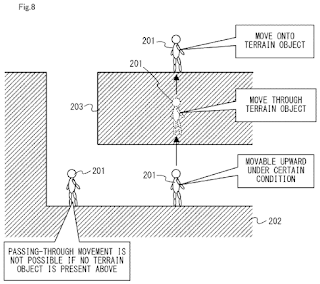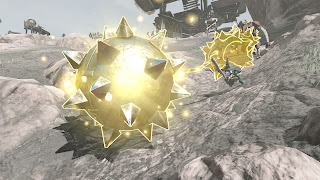While Nintendo hasn't shown us anything new about the sequel to Breath of the Wild at last week's The Game Awards, a couple of game processing patents from Nintendo have emerged that might give us a better idea what we can expect from what we have seen at E3, as discovered by Gamereactor.eu (found via NintendoLife).
The most interesting one is probably patent US20210370175,
which describes the mechanic where Link can move through a terrain object
under certain conditions. The conditions are not met when there
is nothing above you, the terrain object is too far away, or when the
ceiling or surface don't allow for it, either because there are hazards
(like spikes), the slope is too steep, or there are larger steps at the
entry or exit points.
What's important here is that this is an ability that Link can use freely. You can always reach for the sky and as long as there is a suitable surface above you, you can try to go for it. So, it's not tied to portals or anything like that, like it would have been in past Zelda games, which goes hand in hand with everything that Breath of the Wild has done to break the boundaries of the older titles. Though, the limitations might go so far that it works like a set of portals nonetheless if all those conditions are rarely met.
The images of the patent also indicate that this wasn't necessarily a mechanic for entering sky islands, but more of a mechanic for exiting caves back onto the surface. And this could make a lot of sense with what was teased in the E3 2019 trailer, where it looked like they were going for a large underground expansion of the world of Breath of the Wild. It all comes together with this "passing-through" mechanic, where in the early game the primary purpose of this new ability might be to make the spelunking much easier, but later in the game it then lets you go up to the sky islands.
This gives hope that said underground system won't just be separate dungeons, like the Sheikah Shrines were, but something that's truly interwoven with the existing overworld. It would basically become the first Zelda game that has a real "underworld" if this were true. Hyrule Castle in Breath of the Wild was already a dungeon that was seamlessly connected with the overworld, but the sequel could expand this idea to cave systems that span the entire map.
In addition, the ability could be used to shift from multiple layers. The caves could be really deep and have many "floors", so to speak. Likewise, there could be sky islands that float above other sky islands. In these cases the ability could even cascade. Let's say you are deep underground and from there you go up into a cave above you. Then you go up again to the overworld surface, from where you go to a sky island directly above those caves.
You could theoretically enter the floating Hyrule Castle by going under it and then aiming for its dungeon areas at the bottom – given that there aren't any obstacles of course, where for example a film of malice could block you from doing so. It will be interesting to see how this information will be presented to you visually, because the surfaces in question might be very far away. And of course you can't normally see the destination with this type of movement. But it could work like some of the Sheikah Slate Runes, where you hold a trigger and then it shows you all the places where you can go through a terrain above you.
On first glance the possibilities of this ability seem endless, where this could be a massive game changer for Zelda and Action Adventures overall. However, this really depends on how the world gets designed around this. In the original world of Breath of the Wild this wouldn't be all too useful, because there is rarely ever something above you to begin with. Of course this is where the sky islands and potentially also cave system will come in, but we have yet to see how extensive this really will be. Still, after four years of development time we can trust that Nintendo has changed the world of Breath of the Wild significantly to make good use of this. Without a doubt the ability to go up like that is the big gimmick that the sequel to Breath of the Wild has been developed around.
There are also the patents US20210370178 and US20210370179, where the first one deals with the time reversal ability and the other with animations and camera controls during sky dives and archery. Those don't seem to be as interesting, but at least it confirms that the new ability, which resembled Stasis somewhat, truly is about reversing the time for an object.
However, this only applies to movement and moving objects. So, it won't let you unmelt ice or something like that. It's probably limited to objects that currently move in some form, so whenever you hold the L button it will only highlight moving objects as potential targets. In that sense it feels less useful compared to Stasis, which could be used on any movable object in the game world. But it also let's you do things that wouldn't be all that easy to achieve with Stasis, like launching a huge spiked ball back to its sender. So, there is some potential here and it's not necessarily better or worse, just different.
As for the archery and sky diving, it looks like you will be able to do both at once now. When Link is falling, he can turn around to look up, draw his bow, and fire it. This may lead to some really cool fight scenes in mid-air.




1 comment:
I could see the ability coming into play if there are giant boss fights. Say you fight a giant robotic divine beast like boss. Link has to get underneath it and use the ability to "teleport" to it's head where you can damage it.
I'm confident the gameplay will be even better than the 1st. Just hoping for more enemy variety and new overworld bosses like the Lynels and Moldugas since they were so fun.
Post a Comment